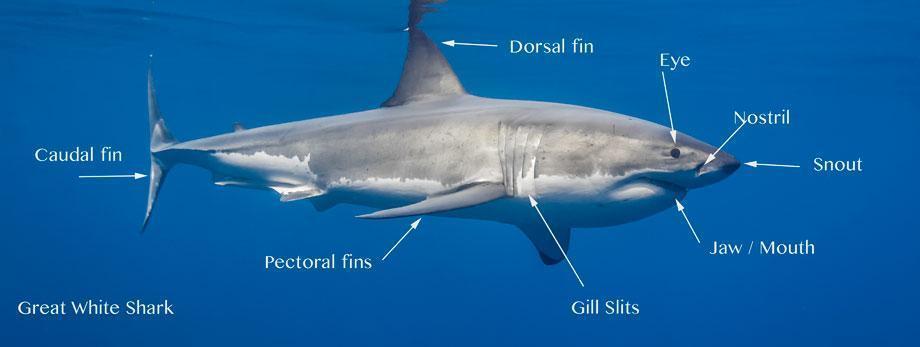Sharks - Did you Know?
Did you Know?
- White Sharks are also known as Great White Sharks, Carcharodon carcharias(Latin)The name comes from two Greek words meaning "sharp" and "tooth" and White Pointer Sharks.
- Their bodies are counter-shaded with a charcoal to black, grey or even dark brown top (dorsal surface) and completely white underneath (ventral surface)
- Counter-shading makes it difficult for their prey to see them
- Great White Sharks have three major fins:
- Dorsal fin - the one on top that can stick out of the water like in the movie Jaws.
- Pectoral fins - there are two of these, one on each side of the shark
- Caudal fin - the fin on the tail of the shark
.jpg)
- One of the most successful predators in the world
- Live on a diverse diet of fish, other sharks, seals, dolphins and even scavenge on dead whales
- They have many different ways to catch their food from chasing fish, to sneaking up on stingrays to attacking from below when trying to eat seal
- Have taste buds inside their mouth and throat and are more fussy than other sharks like tiger sharks
- Have a lateral line made of special hair-like cells which runs from their tail to their head and can detect small water vibrations and currentsUse their electrosense to detect the electric field given off by all living animals and can even find prey hidden under the sand
- They are sensitive to low-frequency sounds as produced by struggling prey
- They use body language and smell to communicate with one another
.jpg)
- Deepest recorded dive was over 1200
- Can breach out of the water over 2m into the air
- One of the most widely distributed sharks found in all oceans, except the polar seas
- Areas with the highest concentrations are Western Cape, South Africa, South Australia, West coast USA, Guadalupe Island Mexico and New Zealand
- Found near the coast and in deep oceanic waters
- Grow slowly only becoming mature after 10 years (males) and 15 years (females)
- Live for more than 60 years
- Reproduce slowly with litters of 2 - 10 baby sharks, called pups
- Gestation is thought to be over 12 months
- Give birth to live young (viviparous)Each pup is between 1.2 - 1.7 meters long when it is born
- There is no parental care
.jpg)
- World's largest predatory shark/fish growing up to 6.1 metres
- Females grow bigger than males
- They weigh over 2000 kgs
- They Have Excellent SensesOne reason sharks, including great whites, are such good hunters is because they have excellent senses including smell, hearing, and sight. They also have a sensitive electro-receptive sense called the Ampullae of Lorenzini. Their sense of smell is so good that they can detect blood in the water from up to three miles away.
- They can see in the day and at night and can see colour
- They don't have eyelids, but instead roll their eyes back to protect them
- Sometimes they will stick their heads out of the water which is called spyhopping
- They have the strongest smell out of all sharks and can smell one drop of blood in a million parts water
Source
Sources:
Info: Linda Chivell; Various Websites; Wikipedia; DICT; Marine Dynamics
Call us and schedule your listing today! Contact Us
Copyright © 2025 Hermanus Online Magazine. Web Development by Jaydee media.



_2575c90c14b57abd62eacb712dfeb81a.jpg)